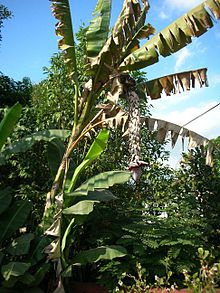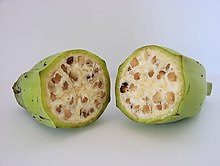
Back موز بالبيسي Arabic موز بالبيسى ARZ ভীমকল Assamese Biu batu BAN Bu'tuhan BCL বিচি কলা Bengali/Bangla Musa balbisiana Catalan Musa balbisiana CEB Musa balbisiana Spanish موسا بالبیساینا Persian
| Musa balbisiana | |
|---|---|

| |
| Musa balbisiana | |

| |
| The fruit of M. balbisiana, showing numerous seeds | |
| Scientific classification | |
| Kingdom: | Plantae |
| Clade: | Tracheophytes |
| Clade: | Angiosperms |
| Clade: | Monocots |
| Clade: | Commelinids |
| Order: | Zingiberales |
| Family: | Musaceae |
| Genus: | Musa |
| Section: | Musa sect. Musa |
| Species: | M. balbisiana
|
| Binomial name | |
| Musa balbisiana | |

| |
| Original native ranges of the ancestors of modern edible bananas: M. acuminata is shown in green and M. balbisiana in orange.[3] | |
| Synonyms[4] | |
Musa balbisiana, also known simply as plantain, is a wild-type species of banana. It is one of the ancestors of modern cultivated bananas, along with Musa acuminata.
- ^ Allen, R. (2019). "Musa balbisiana". IUCN Red List of Threatened Species. 2019: e.T111907032A111907034. doi:10.2305/IUCN.UK.2019-3.RLTS.T111907032A111907034.en. Retrieved 19 November 2021.
- ^ "Musa balbisiana Colla". Plants of the World Online. Royal Botanic Gardens, Kew. Retrieved 2024-04-11.
- ^ Edmond de Langhe & Pierre de Maret (2004). "Tracking the banana: its significance in early agriculture". In Jon G. Hather (ed.). The Prehistory of Food: Appetites for Change. Routledge. p. 372. ISBN 978-0-203-20338-5.
- ^ "Build checklist for Musa". World Checklist of Selected Plant Families. Royal Botanic Gardens, Kew. Retrieved 2013-01-22.
